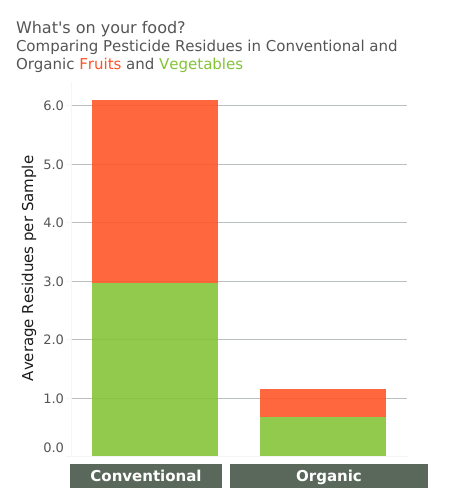New paper: Organic farming significantly lessens reliance on pesticides, reduces dietary risks of pesticide residues in foods

Published: August 6, 2021
Category: Organic News
A new paper from the Heartland Health Research Alliance (HHRA) published in the peer-reviewed journal Agronomy reports significantly lower use of pesticides in organic farming and reduced risks of pesticide residues in foods.
Organic farms use pesticides far less often and less intensively than on nearby conventional farms growing the same crop (see the chart below for an example from California). On organic farms, pesticides are an infrequently used tool, applied only when needed and after a variety of other control methods have been deployed. Plus, only a small subset of currently registered pesticides can be used on organic farms—just 91 active ingredients are approved for organic use, compared to the over 1,200 pesticide active ingredients approved for use on conventional farms. Pesticides approved by the USDA’s National Organic Program (NOP) are typically exempt from the requirement for a tolerance set by the EPA because they possess no, or very low, toxicity. NOP-approved pesticides cannot contain toxic, synthetic additives or active ingredients. Many of them are familiar household products, like soap, vinegar, clove oil, and rubbing alcohol.
On many conventional farms, pesticides are the primary, or even sole tool used by farmers to avoid costly damage to crops by pests. Conventional farmers also have far more pesticide choices. The products registered for many crops include known toxic and high-risk chemicals linked to a number of adverse health outcomes.
Organic eliminates risks from pesticide dietary exposure
Meanwhile, choosing and consuming organic food, especially fruits and vegetables, can largely eliminate the risks posed by pesticide dietary exposure.
In general, the residues of any given pesticide in organic samples are usually markedly lower than the same residue in conventional samples. This is important because pesticide residues in fruit and vegetable products account for well over 95% of overall pesticide dietary risks across the entire food supply. The pesticide-risk reduction benefits of organic farming now extend to a little over 10% of the nation’s fruit and vegetable supply.
While the dietary risks from pesticide use on organic farms compared to conventional farms is the focus of the Agronomy paper, the consequences of heavy reliance on pesticides by many conventional farms are also discussed. These include the emergence and spread of resistant weeds, insects, and plant pathogens that then require farmers to spray more pesticides, more often, and sometimes at higher rates – this is known as the herbicide treadmill. The heavy reliance on pesticides on conventional farms also can impair soil health and degrade water quality. It can undermine both above and below-ground biodiversity, and in some areas has decimated populations of insects and other organisms, including pollinators, birds, and fish.
Transitioning to organic farming
The authors end the paper with a review of actions, policy changes, and investments needed to support those willing to make the transition to organic.
First, “organic farmers need better access to packing, processing and storage facilities linked into wholesale and retail supply chains.” In fact, many farmers hesitate to transition to organic not because of problems adhering to organic farming methods or controlling pests, but because of a lack of marketing opportunities.
Second, agribusiness firms have shown little interest in developing and manufacturing the specialized tools and inputs needed by organic farmers. There are many unmet needs. Tillage and cultivation equipment suitable for small-scale operations is hard to come by, unless imported from Europe.
Infrastructure investments are needed to increase the supply and quality, and lower the cost of compost and other soil amendments. More cost-effective ways are needed for organic farmers—and indeed all farmers—to rely on insect pheromones in disrupting mating and microbial biopesticides that control pests by disrupting their development, reproduction, or metabolism.
Third and perhaps most important is “public education and access to information about the significant health, environmental, animal welfare, farmer, and worker benefits that arise when conventional growers successfully switch to organic farming.”
The case for transitioning most of the approximately 1.2% of US cropland growing fruits and vegetables to organic is strong and bound to grow more compelling. The paper points out that the technology and systems exist to rapidly increase the organic share of fruit and vegetable production from a little over 10% today to over 70% in five to 10 years. The only thing holding back growers is the lack of demand.
As more farmers switch to organic, more investment in tools, technology, infrastructure, and human skills will bring to organic food supply chains the same economies of scale that now make conventional produce so affordable. As a result, over time the organic price premium will narrow as the supply of organic produce expands.
Organic farming reduces pesticide reliance and dramatically reduces dietary risk. The opportunity to promote healthy pregnancies and thriving newborns via farming system changes will join the need to build soil health and combat climate change in driving new investments and policy changes that will hopefully support farmers open to innovation and willing to transition to organic.
Access more information on the paper at HHRA’s website.
Source: Heartland Health Research Alliance
Organic & Non-GMO Insights August 2021








